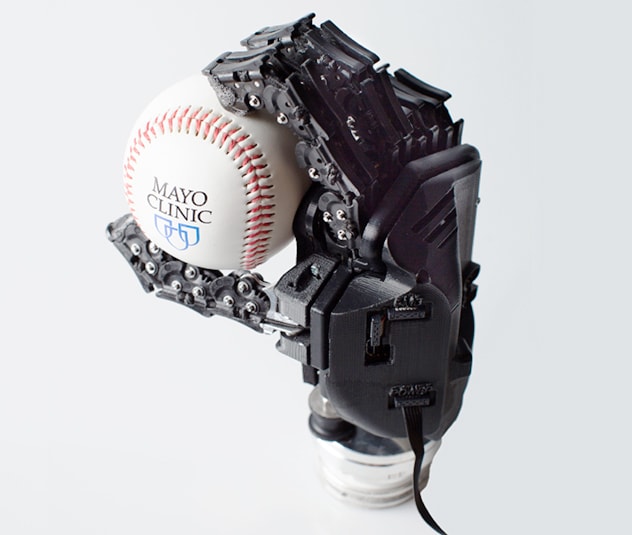June 07, 2019
Despite multiple advances in technology since the debut of myoelectric prostheses, patient satisfaction with currently available upper extremity prosthetic devices remains low. User surveys have identified several key areas requiring improvement, including function, comfort, cost, durability and appearance. To address this challenge, Mayo Clinic researchers are involved in a joint research project studying a novel robotic hand called the SoftHand Pro (SHP).
Preliminary data suggest that the SHP represents a promising alternative to currently available prosthetic hands. Equipped with a new level of grasping versatility and control simplicity, the SHP is a robust and functional prosthetic hand that minimizes cost and weight using an underactuated design with a single motor.
In the SHP, the finger joints are floating, connected axially by elastic bands on the dorsal side. This is different from many commercially available prostheses, in which the finger joints are rigidly fixed together, allowing flexion and extension but not separation. In addition, the SHP joints are able to hyperextend, twist, or even dislocate temporarily and then return to position automatically. This design helps prevent damage caused by impact or collision.
To test this device further, Mayo Clinic researchers and colleagues from the Istituto Italiano di Tecnologia (IIT), of Genova, Italy, and Arizona State University performed the first systematic, clinical assessment of an SHP in participants with transradial amputation and an age-matched control group with intact limbs. This study examined how the SHP performed during a range of daily living tasks and with a relatively small amount of training by the user. Study results were published in 2018 in PLOS One.
Study methods
The clinical assessment involved nine adult participants with below-elbow amputation and nine age-matched and hand dominance-matched control group participants with intact limbs. The primary analyses sought to compare participants' performance using the SHP with their performance using their own prostheses, and to examine the effect of training on participants' performance using the SHP.
Participants with limb loss completed a battery of clinical evaluations using their own prostheses. Participants from both groups were tested using the SHP before receiving any training with the device and after six to eight hours of training. Control group participants with intact limbs were tested wearing the SHP via a forearm adapter. Participants with limb loss also performed a self-evaluation of their existing prostheses and the SHP (following training) using subjective questionnaires.
Primary outcome measures included disabilities of the arm, shoulder and hand measure (DASH) scores, the Jebsen Taylor hand function test, and biomechanical measures such as total grip force, load force sharing between the thumb and finger(s), time to peak grip force, and net torque exerted by the subject at object lift onset.
Study results
Mano robótica SoftHand Pro

Mano robótica SoftHand Pro
La mano robótica SoftHand Pro (SHP) está equipada con un nuevo nivel de versatilidad de agarre y simplicidad de control. Las articulaciones de los dedos son flotantes y están conectadas axialmente por medio de bandas elásticas en el lado dorsal. Las articulaciones de la SHP son capaces de hiperextenderse, torcerse o incluso dislocarse de forma temporal y luego regresar a su posición automáticamente.
Researchers tabulated both objective and subjective results to highlight the strengths and weaknesses of the SHP. Overall, these data demonstrated positive outcomes associated with SHP use. Key findings include:
- Pre-training results show that participants from both study groups found the SHP easy to use.
- After post-training, participants in both groups had significant improvement in the activities measure for upper limb amputees, highlighting the ease of learning the unique features of the SHP. Median improvement in the group with limb loss was 4.71 (p = 0.009) and 3.26 in the control group (p = 0.036).
- The SHP's performance equaled that of participants' existing prostheses for multiple clinical measures and surpassed it for two functional tasks — buttoning a shirt and using a cellphone. This suggests that the SHP has a functional prosthetic design.
- The SHP performed more poorly in tests measuring small object manipulation, indicating a need for improvements in design or training related to this task.
"We believe that the SoftHand Pro may provide an excellent alternative to the prosthetic options currently available to our patients," says physiatrist Karen L. Andrews, M.D., director of Mayo Clinic's Amputee Rehabilitation Service and a lead author on the PLOS One article. "Taken together, these results show the promise of this device and pave a path forward to ensuring higher functionality in the future. Our long-term goal is to use these study findings to help us design and build a low-cost, high-performance prosthetic hand terminal device that will be accepted by patients with below-elbow amputation and allow them to perform a wider range of activities of daily living tasks than allowed by today's commercially available prostheses," says Dr. Andrews.
Looking ahead, the research team will use these data to modify the SHP design as needed. Next steps include focusing on the SHP socket design and the integration of sensory force feedback.
"These study data will provide an important foundation for optimizing the design of the SHP for future testing on a larger number of people with limb loss," explains Kristin D. Zhao, Ph.D. Dr. Zhao is a co-author on the PLOS One article and director of Mayo Clinic's Assistive and Restorative Technology Lab. "Future studies will also assess the extent to which the SHP's functionality and acceptance might benefit from embedding additional synergistic hand motion patterns in this prosthesis."
For more information
Godfrey SB, et al. The SoftHand Pro: Functional evaluation of a novel, flexible, and robust myoelectric prosthesis. PLOS One. 2018;13: e0205653.